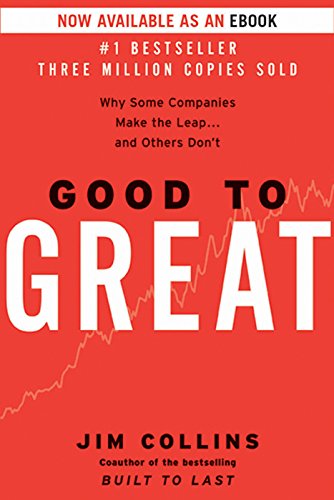

This article is an excerpt from the Shortform summary of "Good to Great" by Jim Collins. Shortform has the world's best summaries of books you should be reading.
Like this article? Sign up for a free trial here .
What is the Stockdale Paradox? And what’s the downside of optimism?
The “Stockdale Paradox” is the stoic acceptance of business realities coupled with an unwavering faith in eventual triumph. This concept was coined by Jim Collins in his book Good to Great.
We’ll cover the Stockdale Paradox and why it’s so important to face the brutal realities of the market in order for your business to succeed.
Facts Over Fantasy
Top-Line Takeaways
- Good-to-great leaders exhibit a psychological duality that Collins dubs the “Stockdale Paradox”—a stoic acceptance of business realities coupled with an unwavering faith in eventual triumph.
- In the same way that good-to-great leaders maintain discipline in their hiring and firing decisions, they stay disciplined in terms of market realities. If the facts are clear, good-to-great leaders will respond to those facts without hesitation.
- Of course, in order to respond to facts, leaders must cultivate a culture in which facts can be discovered and expressed—without fear of reprisal or blame.
- Although good-to-great leaders are always checking themselves against reality, they don’t respond to every change in the economic weather: Once the facts have dictated a course of action, good-to-great leaders will pursue that course doggedly and diligently.
The Stockdale Paradox
Admiral Jim Stockdale was the highest-ranking U.S. prisoner at the infamous North Vietnamese POW camp dubbed the “Hanoi Hilton.” Over the course of his eight-year imprisonment, he was tortured more than 20 times and suffered unimaginable physical and psychic pain.
When Collins asked him which prisoners didn’t make it, he replied, “the optimists.” The optimists were the ones who thought they would be rescued well before they actually were. With each optimistic prediction—“We’ll be out in a month”; “We’ll be out by the end of the season”—that didn’t come to fruition, these soldiers lost more and more of their will to survive. They died of “broken hearts.”
Stockdale endured because he was able to confront and manage the brutal reality of his day-to-day life in the camp—interrogations, torture—without losing hope that one day he would be freed. This is the Stockdale Paradox.
Embody the Stockdale Paradox
Each good-to-great company faced adversity on its path to great, whether in the form of crushing debt (in the case of Fannie Mae) or a massive product recall (in the case of Abbott Laboratories).
Good-to-great leaders approach these challenges in the same way Stockdale did his imprisonment: They accept and address the brute facts of reality while never losing faith that the company will emerge victorious. Facing facts and having faith at the same time is the Stockdale Paradox.
Stockdale Paradox Examples: A&P and Kroger
At the beginning of the 1970s, two well-established grocery companies—A&P and Kroger—were similarly positioned to take advantage of new consumer demand for a one-stop shopping experience: Both companies had almost all their assets invested in grocery stores, and both were strongest in slower-growth areas of the U.S.
But whereas Kroger saw the demand for “superstores”—establishments that sold everything from conventional groceries to prepared foods to nutritional supplements and medicines—and met it by overhauling 100% of their stores, A&P stayed the course—and got buried. From 1973 to 1998, Kroger generated returns 10x the general market and 80x that of A&P.
A&P’s failure wasn’t due to lack of information. In fact, A&P executives rolled out an experimental store, called The Golden Key, that was completely separate from the A&P brand and provided the supercombination store experience. The store was a success, but A&P’s management simply didn’t want to accept the results: The CEO, Ralph Burger, was more concerned with honoring the company’s founding principles than adjusting to a changing marketplace. A&P didn’t embody the Stockdale Paradox.
A&P’s fate was sealed when they embarked on a steep price-cutting strategy to grab market share, which, when the customers still didn’t materialize, resulted in a vicious cycle of cost-cutting and further decline.
The executives who led Kroger’s transformation, when reminiscing about the decision to change strategy, expressed a kind of hardiness. That is, they were going to go where the facts led them, critics and competitors be damned. They knew the value of the Stockdale Paradox.
Cultivating a Culture of Truth
It should come as no surprise that good-to-great leaders make good decisions, but the key is how those decisions are determined. They’re determined by the unvarnished pursuit of facts and good-faith attempts to address those facts.
Following the Stockdale Paradox involves facing the truth. But how does a leader cultivate a culture where truths can be sought and aired? Collins suggests four guiding principles:
1. Question first, then offer answers
- Good-to-great leaders tend to conduct meetings socratically, pumping their team for information and insight and asking tough questions to unearth assumptions.
- The purpose of the questioning is not to elicit consent (“…don’t you agree with me?”) but rather to increase understanding.
- Alan Wurtzel, for example, the leader of Circuit City during its rapid rise, earned the nickname “the prosecutor” for his persistent questioning of his colleagues.
2. Debate for stakes, not for show
- All too often an executive will solicit input from the management team just to give them a sense of being heard, then pursue the direction he or she already had in mind.
- Good-to-great executives, however, cultivated atmospheres where heated dissent and debate had real implications for company strategy.
- For example, in 1965, Ken Iverson was promoted from division head to CEO of Nucor, taking the reins of a nuclear-energy corporation that was hovering near bankruptcy. He fostered a series of debates among his team, some of which escalated into screaming matches, to determine where to take the company next. Each of Iverson’s major decisions emerged from these debates. Thirty years after Iverson ascended to CEO, Nucor had transformed itself from a middling nuclear-energy company into the most profitable steelmaker in the U.S.
3. When a move goes wrong, analyze without blame
- Sub-Level 5 leaders will often attempt to bury bad news or shift blame to subordinates when a decision goes awry.
- Good-to-great leaders, however, don’t shy away from looking mistakes in face; in fact, they conduct detailed autopsies, without ascribing fault, to ensure the same bad decision doesn’t get made twice.
- Joe Cullman, for example, for all his success at Philip Morris, made a terrible bet on the Seven-Up Company, selling it at a loss seven years after acquiring it. Philip Morris managers talked openly to Collins about the lessons learned from the acquisition gone awry, and Cullman himself took sole blame for it.
4. Implement “alarm bell” systems
- Comparison companies like Bethlehem Steel, Upjohn, and Bank of America had all the same information as the good-to-great companies, yet they failed either to capitalize on opportunities or change course to respond to the facts of reality.
- One reason for these failures was ineffective “alarm bell” mechanisms, which are procedures that enable members of the management team to call a total halt to particular programs or strategies and raise concerns. Alarm bell mechanisms allow pressing facts to reach the executive in quick and unvarnished fashion.
- Upjohn, for example, had an idea that its new products would be problematic, yet it ignored the unfavorable data indicating the problems. An effective “alarm bell” mechanism would have (1) prevented those products from reaching market and (2) saved Upjohn money and market share.
Follow these guidelines to embody the “face-the-facts” side of the Stockdale Paradox (the other half, having faith, is often easier to maintain).
Beware Charisma
We’re accustomed to treating “charisma”—a person’s ability to rouse and inspire others—as a plus in a leader.
It’s true that charisma in an executive can be a great advantage; but it can also, without the CEO’s knowing it, stifle truth.
This is because a charismatic leader, through force of personality, can create his or her own reality: Colleagues may be too timid or intimidated to raise vital objections or deliver bad news. A less charismatic leader, by contrast, is less likely to cause others to censor themselves.
Charismatic leaders must stay vigilant to make sure they’re getting the straight facts from their subordinates.
Stockdale Paradox Example: Winston Churchill
During WWII, Churchill was highly aware of his own charisma. He knew that because of his bold leadership and stirring speeches, his subordinates and military commanders might be inclined to give him sugar-coated reports from the field so as not to disappoint him.
To head off any fluff that could result in disaster, Churchill created a department called the Statistical Office whose sole purpose was the compilation of facts. Churchill frequently consulted this Office when making decisions, saying, “Facts are better than dreams.”
———End of Preview———

Like what you just read? Read the rest of the world's best summary of "Good to Great" at Shortform . Learn the book's critical concepts in 20 minutes or less .
Here's what you'll find in our full Good to Great summary :
- The 3 key attributes of Great companies
- Why it's better to focus on your one core strength than get spread thin
- How to build a virtuous cycle, or flywheel effect, in your business






